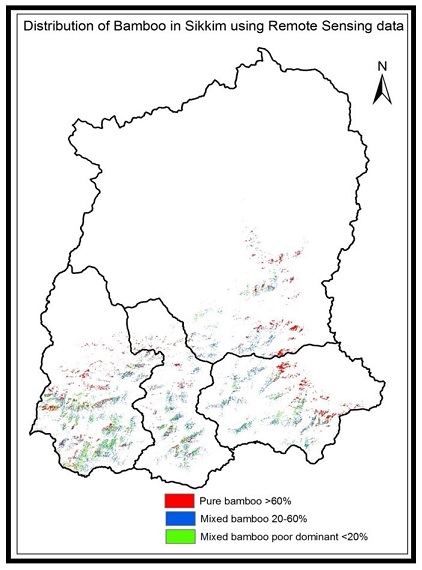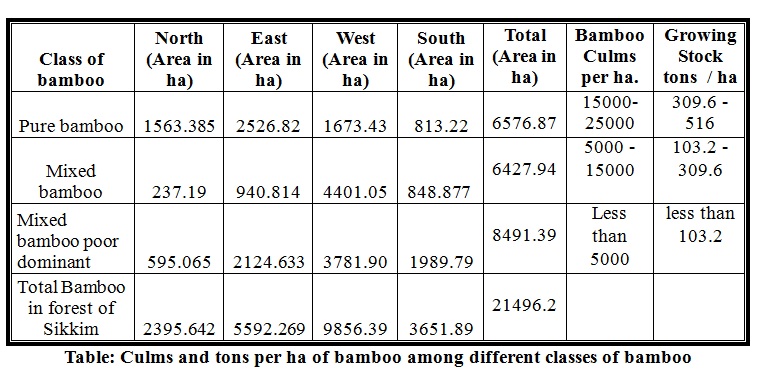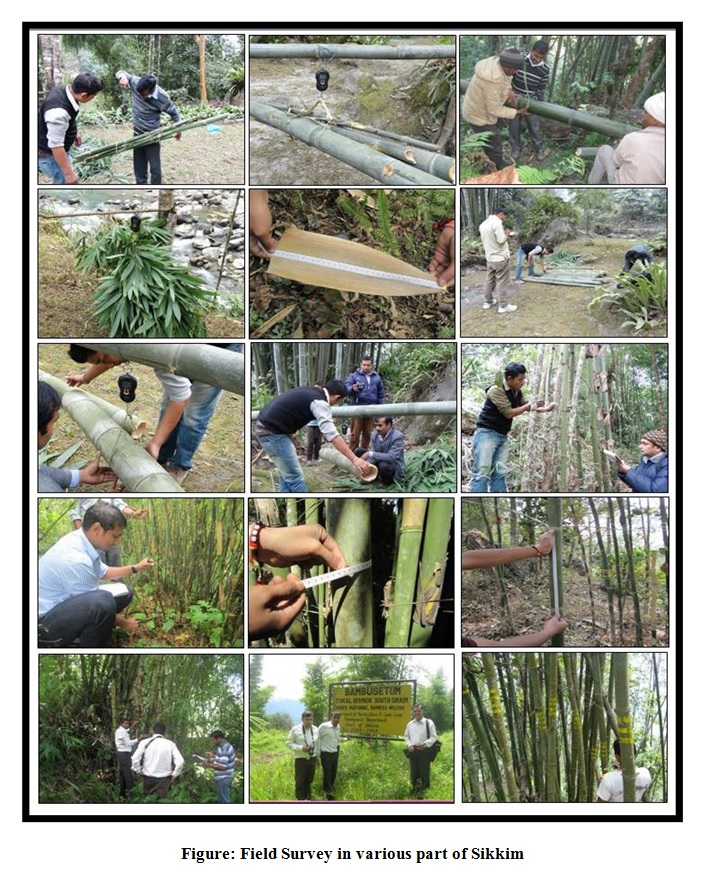Identification of Bamboos in Sikkim Using RS and GIS Technique
 Bamboo
is one of the most common forest resources in Sikkim. Its wide
range of uses and its great versatility qualifies it to be a
multiple use alternative to timber and food to the rural poor
and tribal people. Bamboo related industries both modern and
traditional really play a vital role in solving rural labour,
especially the off-farm season labour, and contribute
tremendously to the income generation, thus alleviate poverty
and improve wellbeing for the rural people.
Bamboo
is one of the most common forest resources in Sikkim. Its wide
range of uses and its great versatility qualifies it to be a
multiple use alternative to timber and food to the rural poor
and tribal people. Bamboo related industries both modern and
traditional really play a vital role in solving rural labour,
especially the off-farm season labour, and contribute
tremendously to the income generation, thus alleviate poverty
and improve wellbeing for the rural people.
The development scenario is clear. It is a common understanding
that natural bamboo is plethora while craft-villages, bamboo
based-furniture, industrial floor, construction material, and
paper industry are in the thirsty of raw materials. The only
concerned issue is how much bamboo resource Sikkim has, where
and what they are. Therefore, there is a great demand to survey
bamboo resource at district levels in order to have appropriate
strategy for exploitation and management.
This is one of the first attempts in Sikkim to estimate forest
resource using satellite images. The IRS P6 LISS III,
multispectral images of 23.5 m resolution image was used for
demarcating bamboo in the forest of Sikkim. Unsupervised and
supervised classification with detailed ground check was done to
delineate all bamboo areas. Items such as paddy, tea, evergreen
forest and to some extent reeds was separated from bamboo by
examining training sites containing these items during
supervised classification. The appearance of bamboo in dry and
wet areas is was slightly different.
The present estimates of bamboo covered area in the forest of
whole Sikkim is about 21496.21 ha which is about 3.03% of the
total geographical area of the Sikkim and 6.23% of the total
forest cover area of Sikkim. West district among the four
district of Sikkim comprises of maximum quantity (14.41%) of
bamboo. Most of the bamboos in this district are found in
south-west regions including Hilley and Barsey area. This is
followed by the east district of Sikkim (8.76%) bamboo covers
Northern and south-eastern region of this district. South
district comprising the Central region comes to third position
(8.37%) in terms of bamboo availability and North district
(1.42%) comprising the south-eastern region comes to forth
position.
The bamboo found in Sikkim Himalayas was categorized into three
class according to its canopy coverage and was estimated that
about 15000- 25000 clump /ha are found in pure natural bamboo
coverage area, 5000 - 15000 clump /ha found in mixed bamboo area
and less than 5000 clump / ha in mixed bamboo poor dominant
area.
Average weight was calculated to find the growing stock in tons/
ha, it was estimated that 309.6 - 516 tons / ha of growing stock
is present in pure natural bamboo coverage area with 15000-
25000 clump /ha, 103.2 - 309.6 tons/ ha of growing stock is
present in mixed bamboo area with 5000 - 15000 clump /ha and
less than 103.2 is present in mixed bamboo poor dominant area
with less than 5000 clump / ha
It was found that almost all of the bamboos found in Sikkim are
used for domestic and social uses. Bamboo is mainly used for
house construction, scaffolding, ladders, mats, baskets,
fencing, garden support, fodder, fishing rods, walking sticks,
tool- handles, pipes, toys, handicrafts etc. Most of the bamboo
shoots are use for human consumption.




